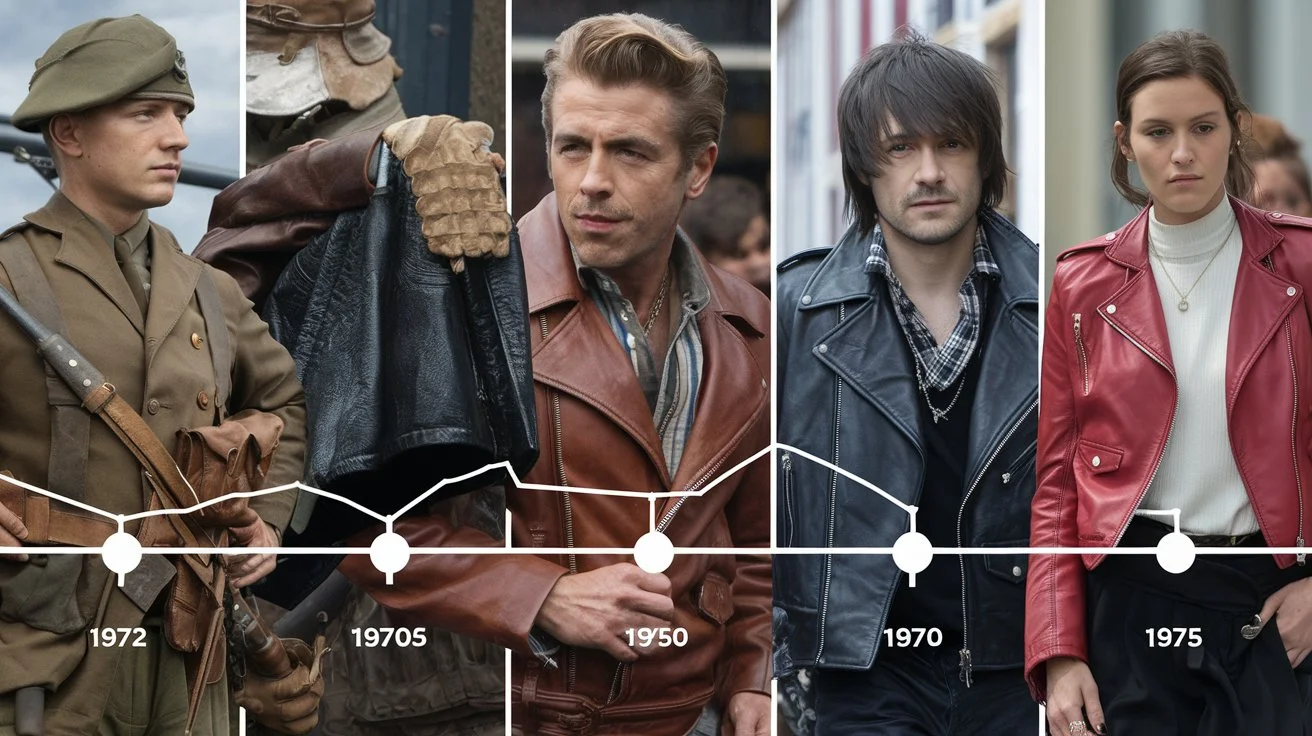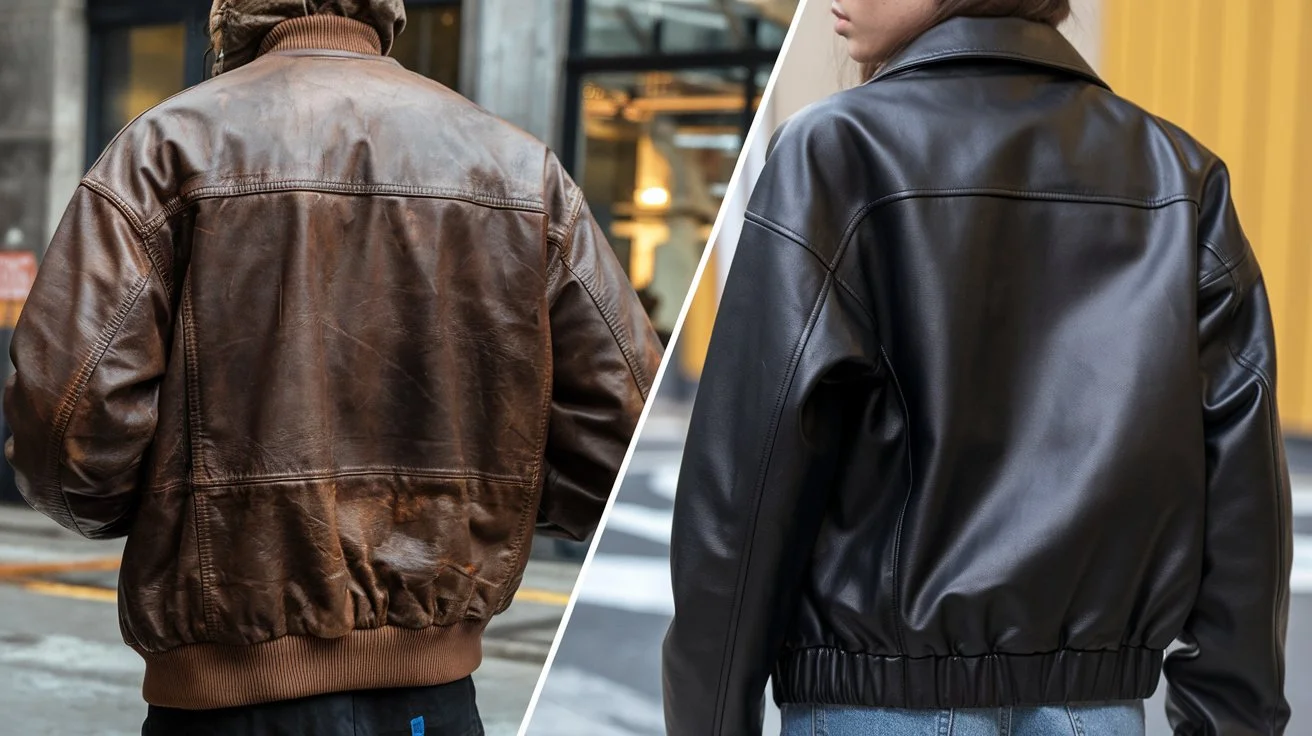Leather vs Faux Leather: What's the Real Deal?
Leather vs faux leather has long been a topic of debate among fashion enthusiasts and sustainability advocates. Whether you’re a fan of the classic pelle pelle jackets or exploring new trends, understanding the differences between these two materials can help you make informed decisions.
What is Leather?
Genuine leather, like that used in pelle pelle leather jackets, is made from animal hides, predominantly cows. It’s known for its durability, unique texture, and the way it ages beautifully over time.
- Durability: Real leather, such as mens pelle pelle leather coats, tends to last longer and withstand wear and tear better than most synthetic materials. A leather jacket can last for decades with proper care, developing a unique patina that tells a story of its own. This longevity makes leather items more sustainable in the long run, despite their higher initial cost.
- Comfort: Leather adapts to your body shape, providing a personalized fit. This is a significant reason why pieces like the pelle pelle motorcycle jacket remain popular. Over time, leather softens and becomes more comfortable, molding to the wearer’s body in a way that synthetic materials can’t match.
- Aesthetic Appeal: Each piece of leather is unique, giving pelle pelle jackets their distinctive, premium look. The natural variations in the hide mean no two leather jackets are exactly alike. This uniqueness adds to the leather’s charm and appeal, making each jacket a one-of-a-kind piece.




What is Faux Leather?
Faux leather, or synthetic leather, aims to mimic the appearance and feel of real leather without using animal products. It’s often used in items like pelle pelle clothing and pelle pelle letterman jackets.
- Cost-Effective: Faux leather is generally cheaper than genuine leather, making it a more accessible option for items like pelle pelle coats for females. This affordability means you can keep up with trends without breaking the bank, making faux leather a popular choice for fashion-forward individuals.
- Variety: Available in numerous colors and finishes, faux leather can be found in stylish designs, including pelle pelle soda club leather. Its versatility allows designers to experiment with bolder colors and textures that might be impractical with genuine leather.
- Easy Maintenance: Faux leather is easier to clean and maintain, ideal for jackets like marc buchanan pelle pelle. Spills and stains can often be wiped away with a damp cloth, and faux leather doesn’t require conditioning or special storage like genuine leather.
Leather vs Faux Leather: Which is Better?
When it comes to leather vs faux leather, your choice depends on several factors, including personal preference, budget, and ethical considerations. Genuine leather, found in pelle pelle leather coats, offers unparalleled durability and style. Faux leather, seen in many pelle pelle coats for men, provides a cruelty-free alternative that’s easy on the wallet.
- Environmental Impact: Faux leather produces fewer environmental pollutants during manufacturing, but its long-term impact can be concerning due to plastic components. Genuine leather, while natural, has a high environmental cost in terms of animal farming and tanning processes. Consumers must weigh these factors based on their values and priorities.
- Longevity: Genuine leather, such as men’s pelle pelle jackets, generally outlasts faux leather, making it a better long-term investment. However, high-quality faux leather has improved over the years and can offer good durability at a lower cost.
- Style and Comfort: Both materials can be fashioned into trendy pieces, but the comfort and unique look of real leather, like in a pelle pelle jacket mens, often make it the preferred choice for many. The decision often comes down to a balance between aesthetic appeal, comfort, and ethical considerations.

Conclusion: Making the Right Choice
In the end, the leather vs faux leather debate boils down to your values and needs. Genuine leather, like that used in pelle pelle jeans and pelle pelle leather, offers a timeless appeal and longevity. Faux leather, on the other hand, provides a cost-effective, ethical option without compromising style.
Whether you’re leaning towards the classic charm of mens pelle pelle leather jackets or the modern, ethical appeal of faux leather, both materials have their merits. Choose the one that best fits your lifestyle, values, and wardrobe needs.
Leather Jacket Care: Tips to Extend Lifespan
Regardless of whether you choose leather or faux leather, proper care can significantly extend the lifespan of your jacket. Here are some tips for both materials:
Caring for Faux Leather Jackets
Regular Cleaning: Use a damp cloth to wipe away dirt and dust regularly. Avoid using harsh chemicals that can damage the leather. Instead, opt for specialized leather cleaners.
Conditioning: Apply leather conditioner every few months to keep the material supple. Conditioning prevents the leather from drying out and cracking, preserving its appearance and durability.
Storage: Hang your jacket on a padded hanger to maintain its shape. Avoid exposing it to direct sunlight for extended periods, as this can cause fading and drying. Store it in a cool, dry place, preferably in a breathable garment bag.
Handling Stains: For stains, use a leather-specific cleaner. Test the cleaner on a small, inconspicuous area first to ensure it doesn’t discolor the leather. Gently blot the stain with the cleaner, avoiding rubbing, which can spread the stain.

The Ethical Considerations
When choosing between leather vs faux leather, ethical considerations often play a significant role. Here are some points to ponder:
Animal Welfare
Leather: Genuine leather involves animal farming and slaughter. For some, this raises ethical concerns about animal welfare and the conditions in which animals are raised and processed.
Faux Leather: Faux leather offers a cruelty-free alternative. However, it’s important to consider the environmental ethics of synthetic production, which often involves petroleum-based materials.
Environmental Impact
Leather: The environmental impact of leather includes the resources used to raise animals and the chemicals involved in the tanning process. Eco-conscious consumers might look for sustainably sourced leather or vegetable-tanned leather, which uses fewer harmful chemicals.
Faux Leather: While faux leather reduces the need for animal products, its production involves synthetic materials, which can contribute to plastic pollution. However, advancements in eco-friendly faux leathers made from plant-based materials are emerging.

Historical Context of Leather Jackets
Leather jackets have a rich history that dates back to early military use, but their journey into popular fashion has seen a dramatic transformation. Originally, leather was used for its durability and protective qualities. During World War I and II, leather jackets were a staple for pilots and military personnel due to their ability to withstand harsh weather conditions at high altitudes. The iconic bomber jacket became a symbol of bravery and adventure.
Post-war, leather jackets transcended their military origins and became a statement of rebellion and counter-culture. In the 1950s, icons like Marlon Brando and James Dean made the leather jacket a symbol of youthful defiance. Rock musicians, especially in the 70s and 80s, adopted leather as a fashion trend, linking it to the rock and roll lifestyle.
Today, leather jackets—especially those crafted by premium brands like Pelle Pelle—are associated with a mix of luxury, edge, and timeless style. From classic biker jackets to more refined designs like Pelle Pelle leather coats, they have evolved into an essential part of men’s and women’s wardrobes.
- Early 20th Century: Leather jackets gained popularity during World War I and II. Pilots and military personnel wore them for their durability and protection against the elements.
- 1950s Rebel Culture: Icons like James Dean and Marlon Brando popularized leather jackets as symbols of rebellion and nonconformity. This era solidified the jacket’s association with youth culture and rebellion.
- 1970s-1980s Punk and Rock: The leather jacket became a staple in punk and rock fashion, embraced by bands like The Ramones and The Sex Pistols. Its association with music and counterculture gave it a rugged, edgy appeal.
- Modern Fashion: Today, leather jackets are a versatile wardrobe staple, transcending trends and seasons. Designers continually reinvent the classic look, blending traditional craftsmanship with contemporary style.


Frequently Asked Questions (FAQs)
Q1: What is the difference between a leather jacket and a faux leather jacket?
A: Genuine leather jackets are made from animal hides, offering durability and a classic aesthetic. Faux leather jackets are synthetic alternatives made from materials like polyurethane, providing a more affordable, cruelty-free option but often lacking the same durability and feel.
Q2: How do I care for my Pelle Pelle leather jacket?
A: To maintain your Pelle Pelle leather jacket, regularly condition the leather with a specialized leather balm or conditioner to prevent drying and cracking. Clean spills immediately with a damp cloth and store it in a cool, dry place to avoid damage.
Q3: Are Pelle Pelle leather jackets worth the investment?
A: Yes, Pelle Pelle leather jackets are known for their high-quality craftsmanship and durability. With proper care, they can last for many years, making them a long-term investment in style and function.
Q4: Can I wear a leather jacket in all seasons?
A: Yes, leather jackets are versatile enough to wear in different seasons. Lightweight versions can be worn in spring and summer, while heavier leather coats are perfect for fall and winter.
Q5: How do I choose the right size for my Pelle Pelle leather jacket?
A: For the best fit, ensure your Pelle Pelle leather jacket fits comfortably across the shoulders, allowing enough room for layering underneath without being too loose. Refer to the brand’s sizing guide for precise measurements.












